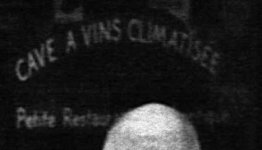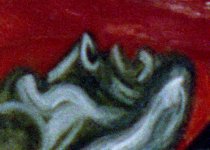Marc-A.
I Shoot Film
<<Warning: this is a foolish thread.>>
Yesterday I wanted to check out whether the highly valued Summicron was really sharp. You would say: of course it is, why questioning? Well, until yesterday, I haven’t been much impressed by my Rigid Summicron, even on 20*30cm prints (translate in inches). You may say that 20*30 enlargement is rather small. You would be right; so I rescanned a picture taken a few months ago, with higher resolution. Here’s the result:
Leica M2, Summicron 2/50 & Neopan 400 (at f/8)
800*509 (no PS at all)

Crop from the same picture 6639*4224 (not the highest resolution of course, but enough to see some details) - it's just over the bald head.

We clearly read: CAVE A VINS CLIMATISEE
Petite restau (bald head ) …
) …
What do you think? I guess film/development can improve the result, but it’s already pretty good.
Now, show us sharpness!
Yesterday I wanted to check out whether the highly valued Summicron was really sharp. You would say: of course it is, why questioning? Well, until yesterday, I haven’t been much impressed by my Rigid Summicron, even on 20*30cm prints (translate in inches). You may say that 20*30 enlargement is rather small. You would be right; so I rescanned a picture taken a few months ago, with higher resolution. Here’s the result:
Leica M2, Summicron 2/50 & Neopan 400 (at f/8)
800*509 (no PS at all)
Crop from the same picture 6639*4224 (not the highest resolution of course, but enough to see some details) - it's just over the bald head.
We clearly read: CAVE A VINS CLIMATISEE
Petite restau (bald head
What do you think? I guess film/development can improve the result, but it’s already pretty good.
Now, show us sharpness!
Attachments
Bosk
Make photos, not war.
I think the unfortunate thing about evaluating the sharpness of images on the web is that you're really comparing scanners as much as lenses/films. Anything output from a top end Imacon scanner is going to look great compared with something spat out of a flatbed.
R
RML
Guest
Bosk said:I think the unfortunate thing about evaluating the sharpness of images on the web is that you're really comparing scanners as much as lenses/films. Anything output from a top end Imacon scanner is going to look great compared with something spat out of a flatbed.
Not to mention the ceaseless argument that sharpness of a lens doesn't exist, though I've yet to hear why not and how else one would name this characteristic.
Marc-A.
I Shoot Film
Bosk, I don't want to compare sharpness; I'm not saying either that scanner doesn't matter. Besides, I mentioned the fact that the film/dev combo can make the picture sharper (or less sharp of course).
My point is that even with an average scan (made on an Epson 4490), we can see details that are not visible on a 20*30 print. I don't think we can do that with any lens, and btw I tried to make the same with a picture taken with my Pentax MX/SMC A.7/50 and ... I couldn't obtain the same result!
So, what is it if not sharpness as a design feature of the lens?
My point is that even with an average scan (made on an Epson 4490), we can see details that are not visible on a 20*30 print. I don't think we can do that with any lens, and btw I tried to make the same with a picture taken with my Pentax MX/SMC A.7/50 and ... I couldn't obtain the same result!
So, what is it if not sharpness as a design feature of the lens?
charjohncarter
Veteran
I think it is very sharp. Regardless of all the others stuff that enters into the equation, to start with a sharp lens makes all the 'accumulation of dangerous ifs' (as Winston Churchill said) less important. But comparing a rangefinder lens to a retrofocus SLR lens isn't a fair comparison. In general, the rangefinder because of their not having to be designed around a flip-up mirror will be better.
ferider
Veteran
Cute girl, Marc 
Here is an example. Heliar 75/2.5. Say hello to the photographer.
Roland.
Here is an example. Heliar 75/2.5. Say hello to the photographer.
Roland.
Dektol Dan
Well-known
Sharpness is relative
Sharpness is relative
Nowadays we have all this talk about micro contrast, which I think is a real thing.
Commonly sharpness is the ability to render detail, but alas, resolving lines on 2D targets just means virtually next to nothing in the real world.
I hold sharpness to be the ability to resolve detail measured against depth of field. The gradations of this is depth as seen on a 3D object is measured in contrast.
Many of today's popular clinically sharp lenses are often very boring in image.
Oddly, many lenses 40 years and older have a life of their own. They are not as 'sharp' as modern lenses and are described as less 'contrast' when in fact they display more gradations of (micro) contrast. It's just that their depth in shaded areas isn't quite as great as the newer lenses can display.
These same popular inexpensive lenses available today (I shant name them for fear of hurting a troll's feelings) are VERY sharp and HIGH contrast, but have no or very little microcontrast.
To find this one has to resort to the older lenses or lay out money for a Summilux, Biogon or Planar. These lenses seem to have the best of both worlds: sharpness defined by micro contrast.
Pony up!
Sharpness is relative
Nowadays we have all this talk about micro contrast, which I think is a real thing.
Commonly sharpness is the ability to render detail, but alas, resolving lines on 2D targets just means virtually next to nothing in the real world.
I hold sharpness to be the ability to resolve detail measured against depth of field. The gradations of this is depth as seen on a 3D object is measured in contrast.
Many of today's popular clinically sharp lenses are often very boring in image.
Oddly, many lenses 40 years and older have a life of their own. They are not as 'sharp' as modern lenses and are described as less 'contrast' when in fact they display more gradations of (micro) contrast. It's just that their depth in shaded areas isn't quite as great as the newer lenses can display.
These same popular inexpensive lenses available today (I shant name them for fear of hurting a troll's feelings) are VERY sharp and HIGH contrast, but have no or very little microcontrast.
To find this one has to resort to the older lenses or lay out money for a Summilux, Biogon or Planar. These lenses seem to have the best of both worlds: sharpness defined by micro contrast.
Pony up!
keithwms
Established
I guess these are acceptably sharp:
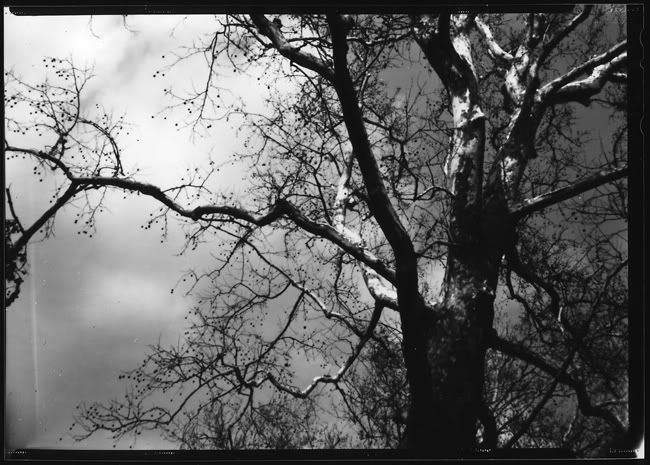
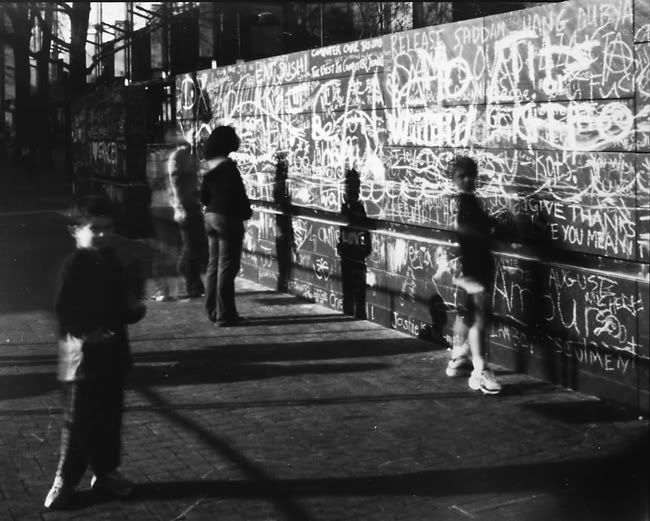
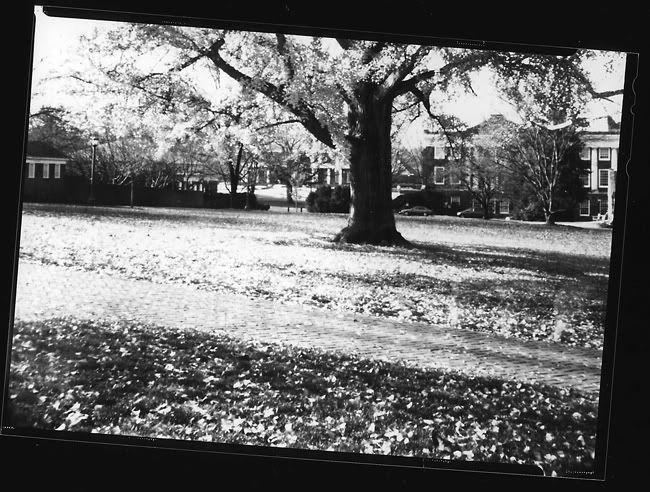
And they were all done with my famous and rare Keithagon lens, which cost me nothing at all. In other words, they were done with a pinhole. On 5x7 film.



And they were all done with my famous and rare Keithagon lens, which cost me nothing at all. In other words, they were done with a pinhole. On 5x7 film.
FrankS
Registered User
It is amazing the sharpness one can realize when using MF and LF film. 
jja
Well-known
Given all the caveats mentioned--and several more, including slight misfocus, camera shake, etc.--below is a sample taken with your average Pentax K1000 and 50mm kit lens (I forget which one, exactly), for purposes of comparison.
Some details: The picture below was taken in Guadalajara, Mexico, some ten years ago, and the negative has been sitting in a shoebox all these years. It is a fresco by Jose Clemente Orozco, painted on a ceiling some 30-50 (I really don't remember) above me. Taken hand-held. I scanned the photos with a Nikon CoolScan 5000 on its highest setting (4800 dpi), with a few enhancements set (don't recall how much I tried to control the grain, which can become more pronounced on a scanner).
Full Frame, then detail:
Some details: The picture below was taken in Guadalajara, Mexico, some ten years ago, and the negative has been sitting in a shoebox all these years. It is a fresco by Jose Clemente Orozco, painted on a ceiling some 30-50 (I really don't remember) above me. Taken hand-held. I scanned the photos with a Nikon CoolScan 5000 on its highest setting (4800 dpi), with a few enhancements set (don't recall how much I tried to control the grain, which can become more pronounced on a scanner).
Full Frame, then detail:
Attachments
jja
Well-known
Let's see if I can paste these on this thread, for easier viewing:




john_van_v
Well-known
I am thinking a small but well-worked emulsion print that is scanned for the web and then possibly printed much larger is the way to go.
LOOP
maraboutflash
Take pictures after the rain...
Take pictures after the rain...
About sharpness I agree with some comments about the difficulty to show it on the web , that the influence of scanning could give more then the lens quality.
Two added comments:
- I notice that shooting outdoor after the rain gives more sharpness, so choosing the right moment to shoot is very important;
- each lens has its own "best" aperture , some are better at 5.6 than 8. 00 and
and
- one can compare pictures only printed.... i hate computers....
Take pictures after the rain...
About sharpness I agree with some comments about the difficulty to show it on the web , that the influence of scanning could give more then the lens quality.
Two added comments:
- I notice that shooting outdoor after the rain gives more sharpness, so choosing the right moment to shoot is very important;
- each lens has its own "best" aperture , some are better at 5.6 than 8. 00
- one can compare pictures only printed.... i hate computers....
Gabriel M.A.
My Red Dot Glows For You
I've yet to hear why it exists. I know images can be sharp by the use of the proper media and rendering of a lens. A sharp lens will cut you. A lens in normal condition won't.RML said:Not to mention the ceaseless argument that sharpness of a lens doesn't exist.
I can see why you're excited about this, Marc-A. Even more so when you consider this is a hand-held shot. Err, I mean, capture.
Marc-A.
I Shoot Film
Thanks for your comments everyone. I want to add the following: I don't value sharpness at all - my favorite lens is the Summitar wide open ... I'm not excited about sharpness either (Gabriel, lenses don't excite me ... what I shoot with could have this effect on me  ).
).
I was just surprised by the fact that we can see a lot of details with enlargment, that are almost invisible on small prints. I guess this has something to do with some quality of the lens, and not only the film/dev/scan/rain/whatever ... If it has nothing to do with the lens, then why would you waste your money for expensive lenses ... only for the bokeh ... my a** And maybe bokeh has nothing to do with the quality of the lens then ... or maybe we can put a "cul de bouteille" (litterally: the a** of a bottle ... that is the bottom) on our cameras and just play on the processing/film...etc.
I was thinking that if I was in the same situation as the photographer in Blow, witnessing a murder, I could rely on my Summicron (or another sharp lens ... that don't cut) to show details that are invisible to the naked eyes.
Anyway, I've warned in the first place: it's a foolish thread and it has nothing to do with the art of photography ... now, play on!
I was just surprised by the fact that we can see a lot of details with enlargment, that are almost invisible on small prints. I guess this has something to do with some quality of the lens, and not only the film/dev/scan/rain/whatever ... If it has nothing to do with the lens, then why would you waste your money for expensive lenses ... only for the bokeh ... my a** And maybe bokeh has nothing to do with the quality of the lens then ... or maybe we can put a "cul de bouteille" (litterally: the a** of a bottle ... that is the bottom) on our cameras and just play on the processing/film...etc.
I was thinking that if I was in the same situation as the photographer in Blow, witnessing a murder, I could rely on my Summicron (or another sharp lens ... that don't cut) to show details that are invisible to the naked eyes.
Anyway, I've warned in the first place: it's a foolish thread and it has nothing to do with the art of photography ... now, play on!
Last edited:
Share:
-
This site uses cookies to help personalise content, tailor your experience and to keep you logged in if you register.
By continuing to use this site, you are consenting to our use of cookies.


